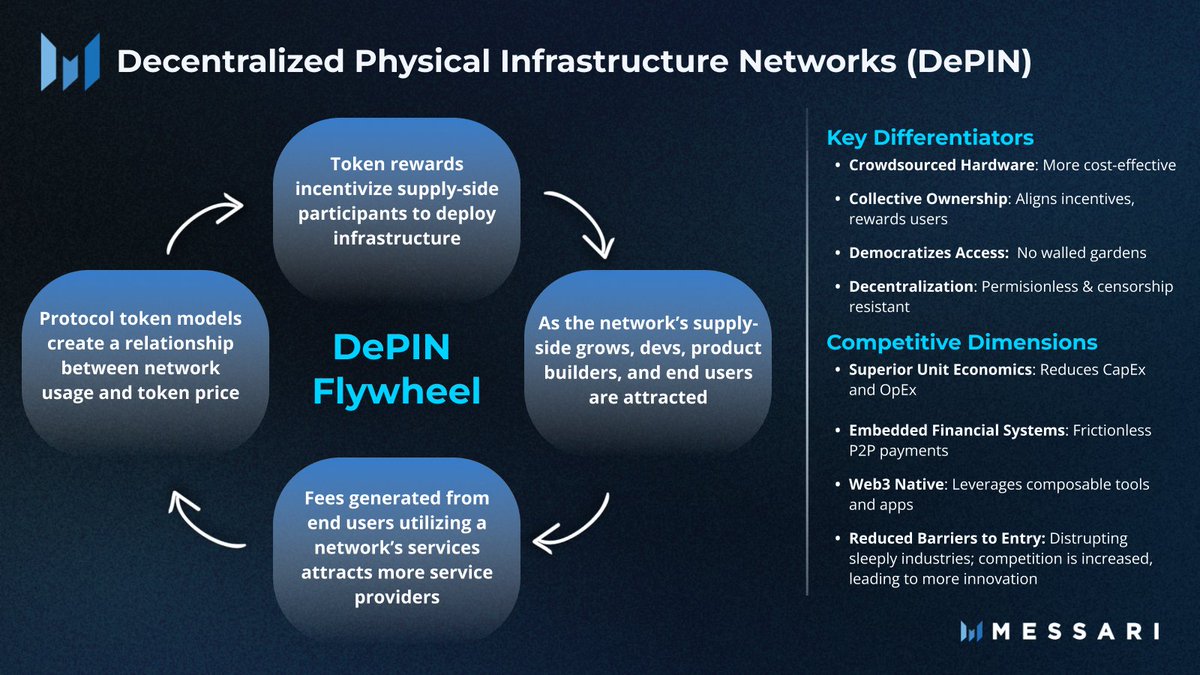The DePIN, or decentralized physical infra networks, narrative has been growing stronger recently.
So I wrote a 7k+ word report on everything you could possibly need to know before the next bull market.
So I wrote a 7k+ word report on everything you could possibly need to know before the next bull market.

DePINs use token rewards to incentivize the crowdsourcing and building of real-world physical infra.
The "real world" part is important because it represents crypto branching out out of the digital realm and into the meatspace.
The "real world" part is important because it represents crypto branching out out of the digital realm and into the meatspace.

DePINs aim to tap into existing Web2 demand by offering cheaper services, while also unlocking new use cases, and supporting crypto apps
The tangible aspect of DePIN and the focus on large existing markets is more digistibile for investors
See bloomberg:
The tangible aspect of DePIN and the focus on large existing markets is more digistibile for investors
See bloomberg:
https://twitter.com/dorloechter/status/1679559327575580696
The initial DePIN sector map was delineated into four categories:
Server, wireless, sensor, and energy networks
However, as distinct variations between these categories became apparent, we chose to add two subcategories: Physical Resource Networks and Digital Resource Networks
Server, wireless, sensor, and energy networks
However, as distinct variations between these categories became apparent, we chose to add two subcategories: Physical Resource Networks and Digital Resource Networks

Physical resource networks incentivize users to deploy location-dependent hardware to offer non-fungible services, such as energy, & connectivity








Digital resource networks incentivize users to deploy hardware to offer fungible digital resources like compute, storage, and bandwidth








The report also covers:
1. How DePINs have successfully built the supply side but are struggling to attract the demand side. Includes what is being done to address this
1. How DePINs have successfully built the supply side but are struggling to attract the demand side. Includes what is being done to address this

2. Emerging trends
In PRNs:
- Leveraging smartphones as the device
- Transitioning from passive to active participation
- Web2 businesses adopting the DePIN model
3. Investment opportunities
- GPU marketplaces
- Geospatial and mobility projects
- DeWi 5G networks
In PRNs:
- Leveraging smartphones as the device
- Transitioning from passive to active participation
- Web2 businesses adopting the DePIN model
3. Investment opportunities
- GPU marketplaces
- Geospatial and mobility projects
- DeWi 5G networks
The report also covers challenges DePINs face, adoption timelines, and most importantly, the business models and moats




This report is packed with information. It's a @MessariCrypto enterprise report which you can read here. Please reach out if you have any questions/request.
messari.io/report/navigat…
messari.io/report/navigat…
• • •
Missing some Tweet in this thread? You can try to
force a refresh














